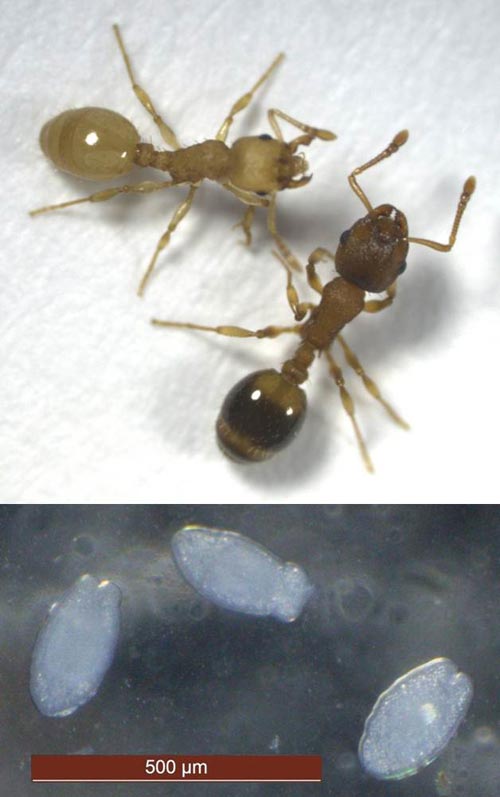Parasitic tapeworm influences the behavior and lifespan of uninfected members of ant colonies

A healthy brown and an infected yellow ant (at the top) and the Anomotaenia brevis tapeworm in its larval stage as it is found in ants (below) photo/©: Susanne Foitzik
Ants are quite often infected by parasites. For example, tapeworms use ants as intermediate hosts for a part of their development phase before they complete their life cycle in their main host. Researchers at Johannes Gutenberg University Mainz (JGU) have now discovered that such parasites not only change the appearance and behavior of infected ants but also have an effect on the behavior of uninfected members of the colony.
The overall aggressiveness of an ant colony diminishes if it contains members who are infected with a parasite. The investigations being undertaken by a team of Mainz-based evolutionary biologists headed by Professor Susanne Foitzik are designed to uncover the effects that parasites have on animal societies and to find out how the parasites manipulate the behavior of their hosts in order to better survive. Their findings have recently been published in Proceedings of the Royal Society B.
The Temnothorax nylanderi ant species is native to western Europe and prefers to build its nests in acorns or dead wood on forest floors. The workers are two to three millimeters long and form colonies of 50 to 200 insects.
They serve as an intermediate host for the Anomotaenia brevis tapeworm, which infects the ants during the larval stage and lives in their intestines. Infected ants turn yellow and thus differ noticeably from their predominantly brown colleagues.
They also become inactive and remain in the nest where they barely participate in social activities, such as caring for the brood. So that the tapeworm can complete its life cycle, its host ant must be eaten by the main host, a woodpecker. In the Lennebergwald forest, a wooded area of 700 hectares to the northwest of the city of Mainz, about a third of all ant colonies have the parasite and some 13 percent of the insects are infected.
“The parasites have developed fascinating strategies to protect their interests and so ensure, for example, their proliferation,” explained Professor Susanne Foitzik. “They attempt to influence the ants in such a way that they are more likely to be eaten by a woodpecker.” There are various methods they employ in the case of Temnothorax nylanderi to achieve their ends.
The study has shown that infected ants live longer than their uninfected nest-mates. “The longer lifespan may be due to modified genetic regulation but could also be the result of the fact that the infected insects enjoy a better level of feeding,” points out Sara Beros, primary author of the study. They also exhibit less marked flight behavior in response to simulated woodpecker attacks, an effect that would increase the parasites' chances of being eaten by their definitive host.
“The parasite's long arm” is how the authors of the study describe the effect that enables the tapeworms to manipulate both the infected ants as well as their uninfected nest-mates. One factor is that these nest-mates have a shorter lifespan and not just relative to the infected animals but also relative to the other ants from uninfected colonies. This is probably the result of the additional stress they experience because of the need to care for the infected animals while also having to do without their help when it comes to other social tasks.
A parasitized colony is also far less aggressive towards intruders of the same species. The researchers assume that the reason for this is associated with the chemical profile of the infected insects that emit a different scent. Each colony has its own nest-specific odor that normally serves as a recognition signal for the group members. If the odor is disrupted by the presence of other scents, this has a negative effect on the readiness to defend the colony against intruders.
Publication:
Sara Beros et al.
The parasite’s long arm: a tapeworm parasite induces behavioural changes in uninfected group members of its social host
Proceedings of the Royal Society B, 18 November 2015
DOI: 10.1098/rspb.2015.1473
Photos:
http://www.uni-mainz.de/bilder_presse/10_zoologie_ameisen_bandwurm_01.jpg
A healthy brown and an infected yellow Temnothorax nylanderi ant
photo/©: Susanne Foitzik
http://www.uni-mainz.de/bilder_presse/10_zoologie_ameisen_bandwurm_02.jpg
A yellow ant infected by the Anomotaenia brevis tapeworm
photo/©: Susanne Foitzik
http://www.uni-mainz.de/bilder_presse/10_zoologie_ameisen_bandwurm_03.jpg
A healthy brown and an infected yellow ant (at the top) and the Anomotaenia brevis tapeworm in its larval stage as it is found in ants (below)
photo/©: Susanne Foitzik
Further information:
Professor Dr. Susanne Foitzik
Department of Evolutionary Biology
Institute of Zoology
Johannes Gutenberg University Mainz (JGU)
55099 Mainz, GERMANY
phone +49 6131 39-27840
fax +49 6131 39-27850
e-mail: foitzik@uni-mainz.de
http://www.bio.uni-mainz.de/zoo/evobio/index_ENG.php
http://www.uni-mainz.de/presse/17031_ENG_HTML.php – press release “Novel genes determine division of labor in insect societies”, 30 January 2014
Media Contact
All latest news from the category: Life Sciences and Chemistry
Articles and reports from the Life Sciences and chemistry area deal with applied and basic research into modern biology, chemistry and human medicine.
Valuable information can be found on a range of life sciences fields including bacteriology, biochemistry, bionics, bioinformatics, biophysics, biotechnology, genetics, geobotany, human biology, marine biology, microbiology, molecular biology, cellular biology, zoology, bioinorganic chemistry, microchemistry and environmental chemistry.
Newest articles

First-of-its-kind study uses remote sensing to monitor plastic debris in rivers and lakes
Remote sensing creates a cost-effective solution to monitoring plastic pollution. A first-of-its-kind study from researchers at the University of Minnesota Twin Cities shows how remote sensing can help monitor and…

Laser-based artificial neuron mimics nerve cell functions at lightning speed
With a processing speed a billion times faster than nature, chip-based laser neuron could help advance AI tasks such as pattern recognition and sequence prediction. Researchers have developed a laser-based…

Optimising the processing of plastic waste
Just one look in the yellow bin reveals a colourful jumble of different types of plastic. However, the purer and more uniform plastic waste is, the easier it is to…



